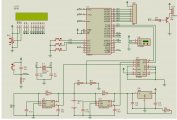基于单片机的电力汽车电池管理系统的设计与研究

基于单片机的电力汽车电池管理系统的设计与研究(任务书,开题报告,外文翻译,论文13000字)
摘要
自21世纪以来,随着基础科学研究领域尤其是材料、物理、化学领域的蓬勃发展,电能存储技术得到了重大的突破,发展十分迅速。在外部环境上,人类社会也正越加越真实得感受着资源紧张的压力和日渐严峻的环境问题。至此,在科学技术推动和社会进步要求的双重作用之下,越来越多的研究人员把目光聚集在了能源管理领域,而其中,电池管理系统BMS(即Battery Management System)作为未来市场上的一个重要角色自然也获得了众多科学家们的长足关注。本论文的研究对象即为以锂电池为基础展开的电池管理系统。
本设计在框架上采用STC89C51单片机为主要控制系统,辅以其他模块完成相应功能。BMS设计要求实现对电池电量进行检测,在AD转换模块上选用了PCF8591。显示模块选用上,使用的是目前最为普遍也最为成熟的LCD1602模块。为了实现电池热管理,综合考虑测温范围和成本,选用DS18B20温度传感器。电压电流采样方面,采用微电阻采样,经过MAX4080模块放大送入AD转换电路。欠压和过流保护电路采用蜂鸣器报警。
本设计在低成本前提下完整实现了电池管理系统所要求的所有功能,在硬件电路和软件代码联调基础上实行了功能优化,最终实验也验证了系统的准确性和稳定性。
[资料来源:https://www.doc163.com]
关键字:单片机;电池管理系统;锂电池;PCF8591
Abstract
Since the 21st century, with the vigorous development of basic scientific research, especially in the fields of materials, physics and chemistry, electrical energy storage technology has made a major breakthrough, and developed rapidly. In the external environment, human society is becoming more and more real and feels the pressure of resource shortages and increasingly serious environmental problems. So far, under the dual role of science and technology promotion and social progress requirements, more and more researchers have gathered their attention in the field of energy management, among which the battery management system BMS (Battery Management System) as the future market An important role has naturally gained the attention of many scientists. The research object of this thesis is the battery management system based on lithium battery.
This design uses STC89C51 single-chip microcomputer as the main control system in the framework, supplemented by other modules to complete the corresponding functions. The BMS design requires the detection of battery power, and PCF8591 is selected on the AD conversion module. The display module is selected and uses the most popular and mature LCD1602 module. In order to achieve battery thermal management, considering the temperature range and cost, DS18B20 temperature sensor is selected. In terms of voltage and current sampling, it is sampled by micro-resistance and amplified by the MAX4080 module and sent to the AD conversion circuit. The undervoltage and overcurrent protection circuits use a buzzer alarm. [资料来源:http://doc163.com]
This design completely realizes all the functions required by the battery management system under the premise of low cost. It is optimized on the basis of hardware circuit and software code linkage adjustment. The final experiment also verifies the accuracy and stability of the system.
Keywords: Single Chip; Battery Management system; Lithium Battery; PCF8591
[资料来源:Doc163.com]



目录
第1章绪论 1
1.1 电池储能技术发展介绍 1
1.2 电池管理系统介绍 2
1.3 国内外发展现状和应用前景 2
1.4 课题研究内容及要求 4
第2章锂离子电池管理系统基础 5 [来源:http://www.doc163.com]
2.1 锂离子动力电池技术 5
2.1.1 工作原理 5
2.1.2 充放电性能 6
2.1.3 电池相关技术参数 7
2.2 锂离子电池管理系统 8
2.2.1 电压/温度/电流数据采集 8
2.2.2 SOC电量管理模块 11
2.2.3 均衡管理模块 11
第3章 BMS硬件部分 13
3.1 编译软件介绍 13
3.1.1 Altium Designer18软件简介 13
3.1.2 Proteus软件简介 13
3.2 硬件电路介绍 14
3.2.1 单片机最小系统 15
3.2.2 LCD1602显示电路 16
3.2.3 MAX4080电流检测电路 17
3.2.4 PCF8591数据获取电路 17
3.2.5 报警电路 18
第4章 BMS软件部分 19
4.1编译软件介绍 19
4.2软件函数介绍 19
第5章仿真测试与结果分析 24
第6章结论 26
参考文献 27
附录实物图 28
致谢 29
[资料来源:http://Doc163.com]
